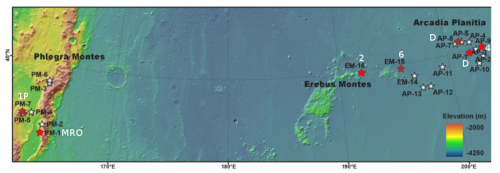SpaceX narrows Mars landing site for Starship to four prime locations

Capitalism in space: During this week’s 52nd Lunar and Planetary Science Conference, one poster [pdf] caught my eye as something significant. It was titled “SpaceX Starship Landing Sites on Mars.” The map to the right is figure 1 from that poster, annotated slightly by me based my earlier stories about SpaceX’s use of the high resolution camera on Mars Reconnaissance Orbiter (MRO) to research potential Martian landing sites for its Starship spacecraft. The stars indicate MRO images, most of which were described and linked to in my last major post about this SpaceX effort in November 2019.
The red spots covering some stars are the big story: SpaceX has narrowed its choice for its Starship landing site to four prime locations (indicated by the bright red spots) and three backup locations (indicated by the dark red spots). The images under the red spots numbered 2, 4, and 6 were linked to in my November 2019 post. The images under red spots marked by a “D” are earlier images taken by MRO when SpaceX was researching a potential Dragon landing site. The images under red spots labeled 1P and MRO are subsequent images taken by MRO since November 2019, with the 1P image previously linked to in a post in April 2020 entitled “The icy Phlegra Mountains: Mars’ future second city.”
The poster outlined why the prime candidate sites — PM1, EM16, AP1, and AP9 — were favored. For example, PM-1 in the Phlegra Mountains “…has the lowest latitude and elevation of the group, a clear association with LDAs [lobate debris aprons that resemble glacial features], well developed polygons, and has the highest SWIM [Subsurface Water Ice Mapping] score for geomorphic indicators of ice.”
EM 16 “…has a clear association with an LDA with nearby brain terrain and the strongest radar return for shallow ice and the highest combined SWIM score.”
AP1 “…appears to be the safest site and has a moderate combined SWIM score for ice.”
AP9 “…has the thickest ice from radar returns and geomorphology indicating shallow ice. It has the highest combined SWIM score for ice, but appears slightly rocky and rough.”
Below the fold are images, rotated, cropped, and reduced to post here, of the four primary landing sites, as well as links to the full images of all four plus the three back-up sites (AP8, EM15, and PM7).

For full images, PM1 can be found here, EM16 can be found here.
These first two sites above are located in the Phlegra and Erebus Mountains, respectively. Thus, there are significant topographical features nearby. Moreover, both sites would land Starship near or on features that resemble glaciers.

For full images, AP1 can be found here, AP9 can be found here.
These second two sites above are both located in the flat somewhat featureless northern lowland plains dubbed Arcadia Planitia. Though there are no obvious glacial features, there is strong evidence that an ice layer is very close to the surface, as indicated by the bright spots in craters. Radar data has also suggested that there is ample water ice only a few feet underground.
If you wish to see the three secondary sites, AP8 can be seen here, EM15 can be seen here, and PM7 can be seen here.
There is a great deal more research necessary before a final choice can be made. As the poster noted:
To further assess these landing sites’ suitability for human missions and persistent human presence on Mars, additional site characteristics should be considered. For each location these include: further understanding the location and safety of the landing sites, the extent and characteristics of the ice deposits, the methods and difficulty by which the ice could be extracted for in situ resource utilization, the proximity and trafficability to the landing site(s), and the near-surface materials that could be utilized for the outpost.
All this data must also tell them whether a rocket ship can safely land at any of these locations, considering that it is thought that ice is so prevalent and close to the surface. It would not do for the ground to unevenly sublimate away from the rocket engine exhaust and cause the rocket to tilt over.
One last note: Back in 2019, when the MRO science team took the first series of images, they labeled each a “candidate landings site” for SpaceX’s Starship. When I posted the first news report in August 2019 on these images the story was quickly picked up by numerous other news organizations, riding on the research I had done.
All well and good. Most news organizations credited me for breaking the story. All, however, including myself, could get little comment from SpaceX about what the company’s intentions were in connection with the images.
The publicity however apparently caused the science team and SpaceX to rethink how they labeled the images.
Since then I have posted many cool images of a number of MRO high resolution photos throughout this region, including the Phlegra and Erebus Mountains as well as Arcadia Planitia, all of which were given geologically descriptive labels that made no mention of Starship. Based on this poster, it appears that some of those images that I had posted were still part of the company’s campaign to pin down a landing site, only they were no longer identifying them as part of that campaign.
Thus, from now on any images from MRO that covers these seven locations are going to be posted here on Behind the Black, in an effort to find out what they are learning about each site, as they learn it. Stay tuned!
On Christmas Eve 1968 three Americans became the first humans to visit another world. What they did to celebrate was unexpected and profound, and will be remembered throughout all human history. Genesis: the Story of Apollo 8, Robert Zimmerman's classic history of humanity's first journey to another world, tells that story, and it is now available as both an ebook and an audiobook, both with a foreword by Valerie Anders and a new introduction by Robert Zimmerman.
The print edition can be purchased at Amazon or from any other book seller. If you want an autographed copy the price is $60 for the hardback and $45 for the paperback, plus $8 shipping for each. Go here for purchasing details. The ebook is available everywhere for $5.99 (before discount) at amazon, or direct from my ebook publisher, ebookit. If you buy it from ebookit you don't support the big tech companies and the author gets a bigger cut much sooner.
The audiobook is also available at all these vendors, and is also free with a 30-day trial membership to Audible.
"Not simply about one mission, [Genesis] is also the history of America's quest for the moon... Zimmerman has done a masterful job of tying disparate events together into a solid account of one of America's greatest human triumphs."--San Antonio Express-News


No Cydonia? Hoagland will be hurt :-P
My two cents on the safety aspects of landing a rocket of this size on an unprepared site: maybe some nose-mounted landing engines in a tractor config. would help, although I’m not sure how much of the blast will dissipate harmlessly in the thin martian atmosphere before hitting the ground. Still, directing the blast a wee bit sideways should help at the cost of some thrust wasted away.
I’m pretty sure someone floated such an idea w regards to the lunar version.
In addition to some high-up tractor thrust (that’s what the SkyCrane is, after all) I think Mars is going to require the first landing to build some form of landing pad for the next ones. The low G and tenuous atmosphere means that any loose surface materials are going to become long-range projectiles… multiple StarShips landing anywhere near each other more or less simultaneously is probably dangerous. Same applies in spades on the Moon.
Who builds the first pads (human or robot) and out of what are big questions. Hauling concrete to Mars is obviously not feasible. I would guess a robotic “Bobcat” could do a basic clearing and leveling, followed by the application of a chemical binder compound to lock down the surface materials.
Once humans are landed in sufficient numbers, serious pads can be built, along with some infrastructure for moving ships to and from them, so multiple ships can use a pad.
Not to totally rain on the parade here, but I must have missed the part where the problem of radiation exposure en route was solved, as well as the whole jell-o muscle thing’ upon landing.
that being said….
Pink Floyd –
Set The Controls For The Heart Of The Sun / Mars Direct
https://youtu.be/a9ntxCcjVjE
9:47
In the conference pdf, I see people from NASA’s JPL and Ames Research Center. So is this the beginning of collaboration between SpaceX and NASA about Mars? I have always seen them as competitors.
Jay: SpaceX is quite happy to work with NASA and the scientist community on its Mars project. Remember, NASA is likely its biggest customer. Musk might want to go to Mars, but he also always focuses on how he can sell the product.
In the end, I strongly believe it will be with Starship/Super Heavy that NASA’s big manned missions to the planets will be achieved. It just will take some time for this to unroll.
Now, I think the bobcat needs in one of the holes-Starship could land there and be a wet stage. I have always been a fan of rockets as payloads-so maybe a one off made for a hole with surface and subsurface exits.
Please tell us biden and harris will be on the flight????
I am thinking that a robotic bobcat or two would go a long way in dealing with this problem. My addition to the discussion would be adding a metal grid of the type used to make improvised runways. Additionally it would make the landing zone pop on the radar.
DannyG: How is the metal grid you describe shipped? If as a roll it would make implementation relatively easy. You would basically put the roll on the ground and let it unroll.
If shipped as sections that are clipped together it might pack easier, but assembling the sections on the ground would likely require humans.
What the heck are those “pebble” looking things scattered all over AP9. They are amazingly similar in size (approx 10 m diameter as far as I can tell) and their distribution is very odd looking. Areas of clusters, areas where there are none and other areas where they seem to be uniformly spaced. Maybe ejectia that’s sublimated? The uniformity in size is really puzzling.
Mars is one freaky-deekey place.
I’m thinking Mr. Musk needs to start putting together a series of landers to check these sites out.
Maybe something that can actually excavate.
I wonder if a private company can use an RTG?
To create a fabricated landing zone on Mars requires a considerable amount of engineering.
Because of the low gravity, traditional earthmoving equipment will not be heavy enough. (but that can be overcome by loading equipment up with ballast or rocks from the area)
There is no oxygen for combustion so unless you make your own out of atmospheric gases, (like the rocket fuel) everything will need to be electric with heavy batteries/motors ship there from earth. Charging the batteries by necessity will need to be atomic because of the power requirements. RTG will keep the batteries and the driver warm, and will last hundreds of years, but have a low electrical output.
Because of unknown surface characteristics, what looks like hard surface might be mud underneath because of the chosen wet locations. A surface grinder might be more useful to prepare a suitable platform out of a tested rocky surface. Smaller in weight, size, energy requirements.
The surface can be treated with a hardening agent that doesn’t need oxygen to cure, and is resistant to breaking down under rocket exhaust heat. There are some chemicals already in use, but may not work at Mars temperature.
https://www.polypavement.com/
There are epoxies used by the military to create runways in the desert in only a few days. Once percolated into the soil, it hardens like concrete.
There are other methods to support a craft in unknown soil properties. Some are discussed in the first landing on the moon because they were unsure that it would be like “powdered cement” on the surface.
On Mars they will need adjustable landing struts to keep the craft upright, this may include a length of spring steel rod that pushes into the ground using the weight of the craft. And/or stabilizers that fold outward that are used to stabilize cranes.
If the evidence for water has long evaporated, or is too deep from the surface for convenient use, they’re are alternative sites that are certain to have what they need.
The polar ice is on the surface, and is only 50° colder then what is already far too cold. An RTG on a rover can melt a dust free habitable tunnel complex into the ice ready for air locks and carbon insulation in a stable (hopefully) radiation free artificial environment requiring minimal construction. Ancient water, methane, nitrogen, as well as as an abundance of solid carbon dioxide will be available upon colonization. The RTG can also be used in the separation process to melt carbon dioxide ice in a pressure container, into a high-pressure liquid that can be used to generate power in a two-stage process. High pressure liquid to high-pressure gas in the first stage then high-pressure gas turning a second turbine into low pressure as it’s vented outside creating far more power then the RTG can ever make as an electrical device. This is sustainable as the vented gases will refreeze and can be recycled endlessly. Life on Mars will need an abundance of power, this is the best available until nuclear power plants can be constructed and brought online. (Hopefully Russia will allow the purchase of some of their nuclear submarines for this purpose)
Once a staging area has been secured with manufacturing process enabled probably by 3-D printing, the rest of the planet can be surveyed, sampled, underground tunnels mapped and cleared of debris and reinforced by construction materials supplied by the polar intermediate materials colony. Baby steps…
Max–
I’d enjoy your comments on (potentially) utilizing some formulation of (generically) shotcrete (and associated machinery), for fabricating structures off-world.
(These people have some great case-studies on terrestrial fabrication. )
https://shotcrete.org/
Max,
It would require very large RTGs to do the work you are describing.
What a practical Mars base needs is a nuclear reactor. That should be one of the first things landed (if not the first) in any serious attempt at a permanent base.